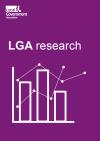Research Report, May – June 2023: This survey aimed to capture data on the current appetite for virtual meeting options at statutory council meetings and understand the positive and negative effects of returning to in person only council meetings in England.
View all Research articles
Key findings
Demand for legislative change
- Consistently, councils which responded to this survey made it clear there was a demand for the powers to use virtual meeting technology
- Nearly all (95 per cent) of the councils who responded have indicated they wanted the power to re-introduce virtual meeting technology at statutory meetings
- The vast majority (85 per cent) of councils would use virtual meeting technologies at statutory council meetings
- Nine in 10 (90 per cent) councils answered that their councillors would make use of virtual attendance options to attend council meetings as a reasonable adjustment
- Seven in 10 (70 per cent) of councils reported that at least one councillor has enquired about using virtual meeting technology for a reason other than a reasonable adjustment
- The three most common reasons given for this demand were work commitments, excessive travel times, and childcare commitments Impact of returning to in person only meetings
- Nearly one in 10 councils stated that at least one councillor had voluntarily stepped down entirely or partly due to the requirement to meet in person
- The data provided by councils on the impacts of the return to in person meetings presents more of mixed picture, when compared to the demand
- A quarter (26 per cent) of councils have reported a drop in attendance to meetings but the majority (63 per cent) have said there was no change
- One fifth (22 per cent) of councils claimed that the end of virtual meetings had a negative effect on local decision making in comparison to the more than one tenth (13 per cent) which said it was positive. The majority (65 per cent) have said there was no change
- A very similar percentage stated the impact of the return to in person council meetings on the accountability of elected members was positive (15 per cent) or negative (11 per cent)
Councils were asked to give examples of when the return to face-to-face meetings had a positive or negative impact.
Positive impacts
- Improved internal communication such as informal communication and networking between councillors
- Better outward facing communication with the public as people could see councillor meetings in person
- Meeting in person negated the negative effects of virtual meeting technology such as WI-FI issues
- Debate between councillors is of a higher standard
Negative impacts
- Some councils mentioned that traveling in for the meetings had made it more difficult to attend. This issue was felt acutely by those with outside obligations such as work or caring responsibilities, and those in rural areas
- Poor attendance due to logistical issues such as travel
- Individual councillors who have experienced health issues or disabled councillors also found in person meetings more difficult to attend
- Another negative impact of was the quality of the meetings such as in person debate becoming more combative in person than online
Mixed impacts
- There was some difference in opinion regarding councillor conduct during in person meetings. Some councils thought that behaviour was better during when meeting face-to-face. In contrast other councils stated that it can lead to more negative conduct

- Published by:
- Reference code:
